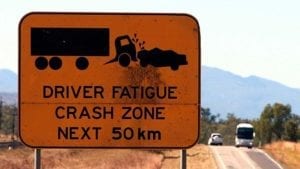Tom Halliwell provides an eye-opening assessment of driver fatigue in the transport industry today.
We all know driver fatigue is a problem. When there is an accident out there, the drivers always shift the blame; someone else pushed them off the road, or there was an animal in the road. Drivers don’t believe fatigue causes accidents – you can’t blame them, considering their jobs are on the line. In the transport business, operators and owners face numerous big risks that are uninsurable. It is up to you to get your risk management policy in line and navigate your way through an economic meltdown, varying weather conditions, draughts, the political climate, and competition. The good news is that you can transfer the risk to your insurance company. You take the risks out of your business and give it to someone else. The other good news is that good risk management reduces the cost of insurance and fits more easily into your cash flow. Your claims will ultimately dictate the cost of the insurance. Therefore, it is very important that you understand your specific risk profile. It will differ from one to another. Claims and causality In this industry, 77% of insurance claims are for vehicles and cargo damage, 9% for theft and hijacking, 7% for damage of third-party property, 4% for fire and 3% for smaller claims. From the video footage and data we have, we know that 35% of all damage to heavy goods vehicles is caused by fatigue, with reckless driving accounting for another 20%, speeding for 18%, texting for 15% and the rest being third-party causes. Since introducing video footage, we can clearly see there is a big difference in the scale of incidents when drivers fall asleep without wearing a safety belt, compared to when they do wear them and fall asleep. Without safety belts on, the accidents are disastrous – in many cases, resulting in total vehicle and load write-offs. But in cases where drivers use seatbelts and fall into microsleep, they often wake up in their seats and are able to grab the steering wheel. Often those trucks are still facing forward, with the drivers trying their utmost to keep it on its wheels. This limits the damage and helps keep the cargo on board.High average mileage leads to fatigue and every driver is fatigue prone at night. Operators might tell their drivers to rest from 23:00 to 04:00, but they often violate those rules and just keep driving. It is also hard to focus when over speeding; it is demanding. Driving 110 km/h to 115 km/h with loads on the trailer tends to tire out drivers. Texting doesn’t really lead to fatigue, but it doesn’t allow drivers to focus. And passengers on board are a distraction.
Sometimes, high accident rates and fatigue are related to salary structures. If you underpay drivers, they have to work harder to earn more money. They will use your assets to subsidise their income, which leads to fatigue. Case study We had a case where a transporter incurred R17 million in vehicle and cargo claims in the space of 14 months, in a fleet of over 90 vehicles. So, we collected all the claim forms to establish the times and locations of the accidents, and what cargo was being carried. We learnt that new drivers were being paid far less than the more senior drivers. Subsequently, all major accidents were made by the new drivers and the majority were exceeding the company’s speed limit policy and were pushing the kilometres, violating the company’s policy on drive times. The new drivers averaged between 17 000 km and over 19 000 km a month, and they all had single vehicle accidents. We decided to implement a risk management programme that included strict rules for over speeding and the grounding of vehicles during certain times in the evening. All vehicles were fitted with advanced 24/7 monitoring systems so that we could tell the employer when drivers transgressed. The salary structure was changed for new drivers and he upgraded his employment process and the results now speak for themselves. Tom Halliwell is the CEO of insurance specialists Libra Brokers.







